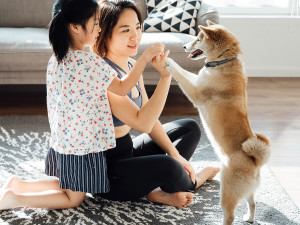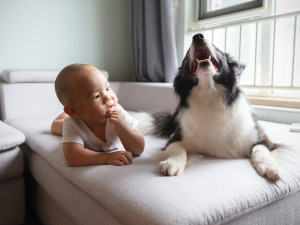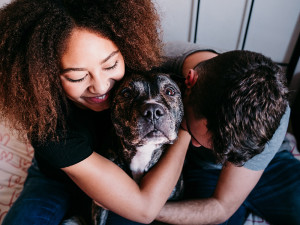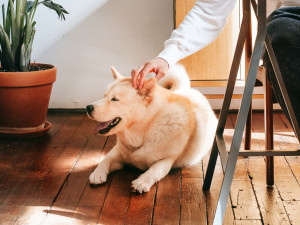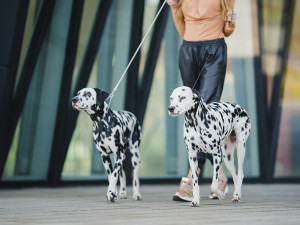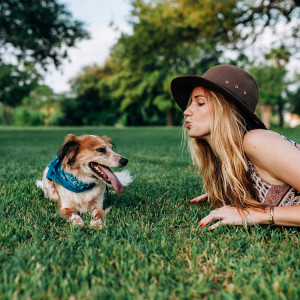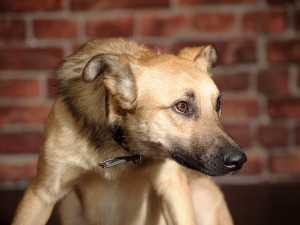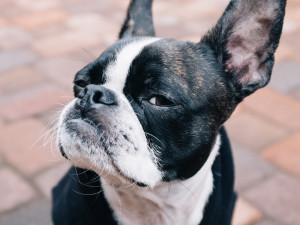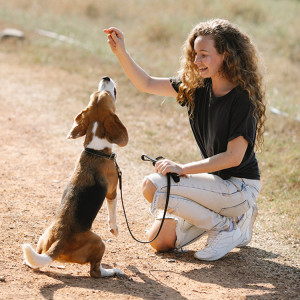How to Prepare Your Dog for Your New Baby
Keep these two words in mind: Start now.
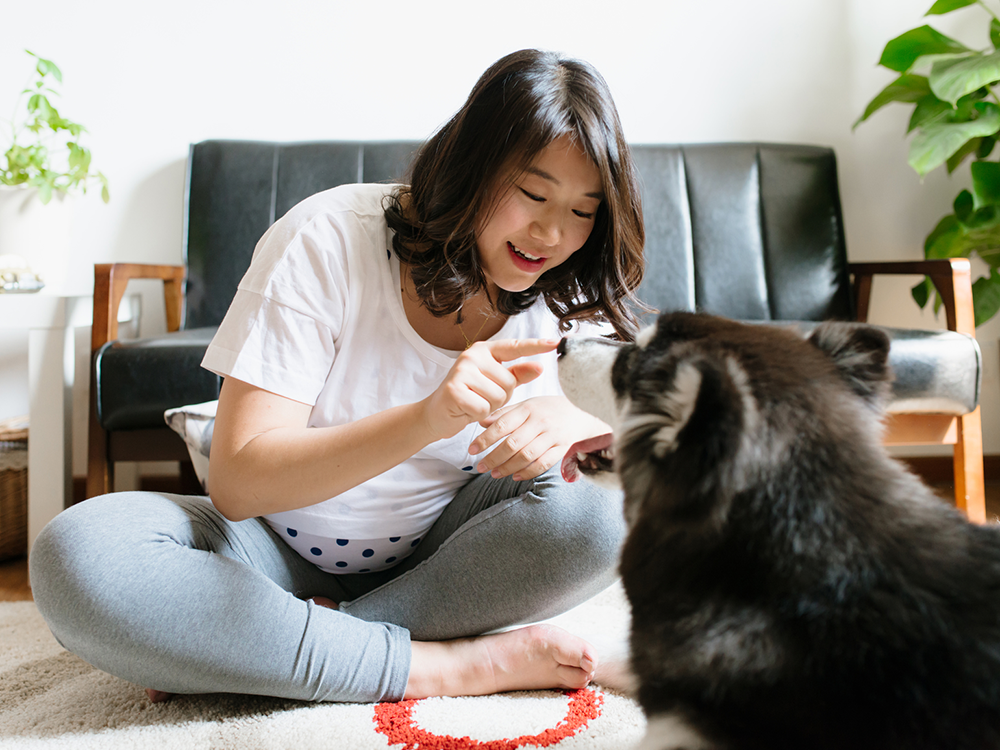
Share Article
Yay, a baby (a human one this time!) is going to enter your home, your heart, and your lives. I love being a parent, so I am thrilled for you. As a mom, I welcome anyone starting the journey into parenthood with joy and warmest wishes, but with only one piece of advice: Enjoy your child at whatever stage they are in.
As a dog trainer and behaviorist, it’s a different story because I have all kinds of advice, starting with this: Begin preparing your dog now for this biggest and most wonderful of life changes. Change is hard, and the less your dog associates the changes with the new baby, the easier the transition will be. That’s why you should start right now; it doesn’t matter if you just tossed the positive pregnancy test in the trash a minute ago, you are a couple of months from your due date, you have just found out you will be adopting or fostering an infant, or the baby is about to be born. Do whatever you can with whatever time remains before the baby’s arrival, and the early effort will pay dividends.

Get (totally free) deals for food, treats, accessories, tech, and way more pet parenting must-haves.
opens in a new tabGet your dog used to new equipment and the new set-up of the house now.
The more you can make changes ahead of the baby’s arrival, the smoother the transition will be for you and your dog. If the baby gear shows up months ahead of time, your dog will already be used to it when the baby arrives. It’s better to adjust to the swing, the crib, the bouncy seat, the car seat in the car and at home, etc., now rather than overwhelming your dog with adjusting to those things and the baby at the same time. Allow your dog to sniff these items when you bring them home and after they are in place (as long as they are in a room your dog will be allowed in) to help the dog accept them.
Move any furniture that will be part of the rearranging-for-baby plan now. Changing things around in the house can make dogs feel a touch on edge, and it’s better to avoid doing that at the same time as the big changes that naturally happen when the baby arrives. Help your dog by putting up any baby gates you plan to use right now, and by walking your dog while also pushing a stroller. Any change you can make now instead of later is a way of being kind to your dog so they aren’t hit with all the changes all at once.
Change routines now.
Just as you don’t want your dog to associate the baby with all the physical changes and new items, the same goes for changes in routine. Make as many of them as you can ahead of time so the baby’s arrival is less of a shock for your dog.
If you dog will be taken out by a dog walker or attend daycare opens in a new tabafter the baby comes, have your dog experience some of those walking sessions or daycare days now. The expense of these services can be an issue, so you don’t have to schedule them as frequently now as you plan to after the baby comes. Just make sure you have enough dog walker or daycare sessions ahead of the baby’s arrival so that your pup is accustomed to them.
Follow your new schedule now as much as possible. If your dog will not always have that long walk first thing in the morning once your baby enters the picture, start mixing it up. Continue to walk your dog a lot, but vary when you go so your dog is more accepting of variations in schedule ahead of the big permanent shift. Creating some unpredictability in routine is a great way to prepare your dog ahead of time for the adjustments of a new baby, so add in some small variations to when you feed your dog, and when you play, too.
New sounds and smells should predict treats.
Some of what stresses dogs out about new babies involves new sounds and new smells. For example, to avoid the upsetting experience of a baby crying, which usually means the dog will be ignored, teach your dog ahead of time to handle this sound. You can use professional sounds of a crying baby or just record a friend’s baby and then play the sound for your dog. Don’t just play the tape and expect your dog to get used to it. Instead, actively teach your dog that crying predicts delicious treats. Offer your dog something wonderful — treats, or a stuffed food toy, or something great to chew — when the crying starts. Start with the volume very low and only play if for a few seconds.
Gradually, increase the volume until even loud crying is greeted with the wagging tail of a dog who expects a great treat. Then, slowly start increasing the length of time the crying lasts, allowing your dog to enjoy their treat while the crying continues. Once your baby arrives, keep offering great treats when the baby cries so your dog is not upset by the sound or by your attention going to the baby.
Similarly, teach your dog that the smells of baby wipes, diapers, and other baby products mean treats are coming. It’s hard to mimic the real smells of a baby, but if your dog is used to getting treats when you’re at the changing table, it’s easier to teach your dog to accept the actual experience of a diaper change for the baby and all the real smells associated with it. Use treats in this context before and after baby’s arrival (put a jar of treats near the changing table) to help your dog.
Start teaching new rules now.
If your dog will be sleeping in a different location after the baby joins the family, make that change now. If that means your dog will no longer be allowed on the bed or will be on a dog bed in a new spot, it’s a kindness to get your dog used to the new place as soon as you can, and certainly before the baby comes. Anything you can do to avoid having the dog feel like the baby displaced them or took their place will make the transition an easier and a happier one.
Similarly, if there will be new rules about being on the furniture or if the dog will no longer be allowed in the baby’s room, start teaching those new boundaries now. Many dogs are expected to ride in a new location in the car after there is a baby on board, so that is another pattern to let your dog know about now, rather than the first time they get in the car with the baby.
Plan ahead for ways for your dog to amuse themselves or get attention.
It’s really hard to give your dog as much attention after the baby arrives as you did before, and that’s OK — really it is. It’s unbelievably time-consuming and overwhelming to care for a baby, and I know I couldn’t walk, train, or play with my dog as much in those first few months. Luckily, when I had my kids, some of my dog-training friends helped me out with extra walks, training, and play sessions, and I had a plan in place to help him enjoy that period of his life anyway. You should have a plan, too, for your dog’s sake, and so you don’t feel guilty.
Ask ahead of time for helpful friends to walk your dog or to give them extra attention when visiting. Many people want to help out a family with a new baby, but not everyone is adept at delivering meals or cleaning the house. Some of us are best able to help by walking dogs or playing fetch in the yard. Round up the helpful people in your life and ask them ahead of time if they can do this.
Buy lots of treats, toys, and items to chew on so you are ready to offer your dog an activity that does not interfere with baby duties. Food toys to stuff, antlers, Nylabones, Greeniesopens in a new tab, and cow hooves are all helpful, as are many other things that keep dogs busy. Check with your veterinarian about which items they recommend and which should be avoided, but have a lot of them on hand before the baby arrives.
Teach specific training skills ahead of time.
It’s super useful in any situation to be able to communicate to your dog what you would like them to do, and that’s especially true when a new baby is on the scene. The more training your dog has, the easier it will be to live happily together as a parent to dogs and kids. Think carefully about what you will want your dog to be able to do at that time, and start training your dog now to be good at those skills. Here are my top picks for skills worth teaching dogs when a baby will be joining the family soon.
Tell them to “go to their place.”
Being able to send your dog to their “place” (this could be a mat, a bed, a crate or a laundry room) is really helpful. I used this cue when one of my sons spit up, and I didn’t want my dog’s help cleaning it up (ugh). I also used it when I wanted to put them on the floor for a second to attend to something in the kitchen while I couldn’t keep my eye on things. It’s also useful when guests come over if they want to see the baby, but are not so into the dog.
Work on “four on the floor” for greetings.
If your dog jumps up on you when you come home or enter the room, teach your dog a more polite greeting that involves staying on the ground. It’s not safe to have a dog jumping on you when you are holding a baby, and it can be scary for everyone. This applies not just to big dogs, but also to little dogs, who can still cause tripping and balance issues.
Encourage good leash manners.
It’s harder to get our dogs out for walks when we are taking care of a new baby, and it’s especially challenging if they pull on the leash, run in front of us constantly so we are at risk of colliding with them, or wrap themselves around trees and posts while on leash. Dogs who do these things are less likely to get to go on walks after the baby arrives, so do everyone a favor and work on those leash manners now. Dogs who walk nicely on leash are welcomed more often to outings that involve carrying the baby or pushing them in a stroller, so good leash manners are an important skill related to a good quality of life.
Preparing your dog for the new baby can be summarized in two words: “Start now.” Nobody is ever able to fully prepare a dog (or themselves for that matter!) for the arrival of a new baby, but starting now is the best plan for getting the whole family as ready as possible. Do as much as you can ahead of time. Your future self will thank you, and your dog’s life will be better.

Karen B. London, PhD, CAAB, CPDT-KA
Karen B. London, Ph.D., is a Certified Applied Animal Behaviorist and Certified Professional Dog Trainer who specializes in working with dogs with serious behavioral issues, including aggression, and has also trained other animals including cats, birds, snakes, and insects. She writes the animal column for the Arizona Daily Sun and is an Adjunct Professor in the Department of Biological Sciences at Northern Arizona University. She is the author of six books about training and behavior, including her most recent, Treat Everyone Like a Dog: How a Dog Trainer’s World View Can Improve Your Lifeopens in a new tab.
Related articles
![A woman playing with her dog making a kiss face at it.]() opens in a new tab
opens in a new tabHow to Avoid a Dog Bite to the Face
Step one: Never put your face close to theirs.
![Scared tan dog against brick wall background]() opens in a new tab
opens in a new tabDoes Your Dog’s Growl Mean Aggression?
Remember, dogs have more than one emotion.
![Young woman sitting at desk petting her senior Great Dane]() opens in a new tab
opens in a new tabHow to Speak “Dog”
Lili Chin’s book Doggie Language illustrates how dogs communicate — beyond ear perks and tail wags.
![Boston terrier being stubborn]() opens in a new tab
opens in a new tabDog Training — DIY or Hire a Pro?
When it’s time to call in reinforcements.
![Female dog trainer raising a treat above a beagle dog's head]() opens in a new tab
opens in a new tabYour Dog’s Trauma Triggers Are Everywhere. Fear-Free Training Can Help
“America’s Veterinarian” and the founder of Fear Free Pets, Dr. Marty Becker, on how this method makes vet visits, training sessions, and grooming appointments less stressful for pets.
